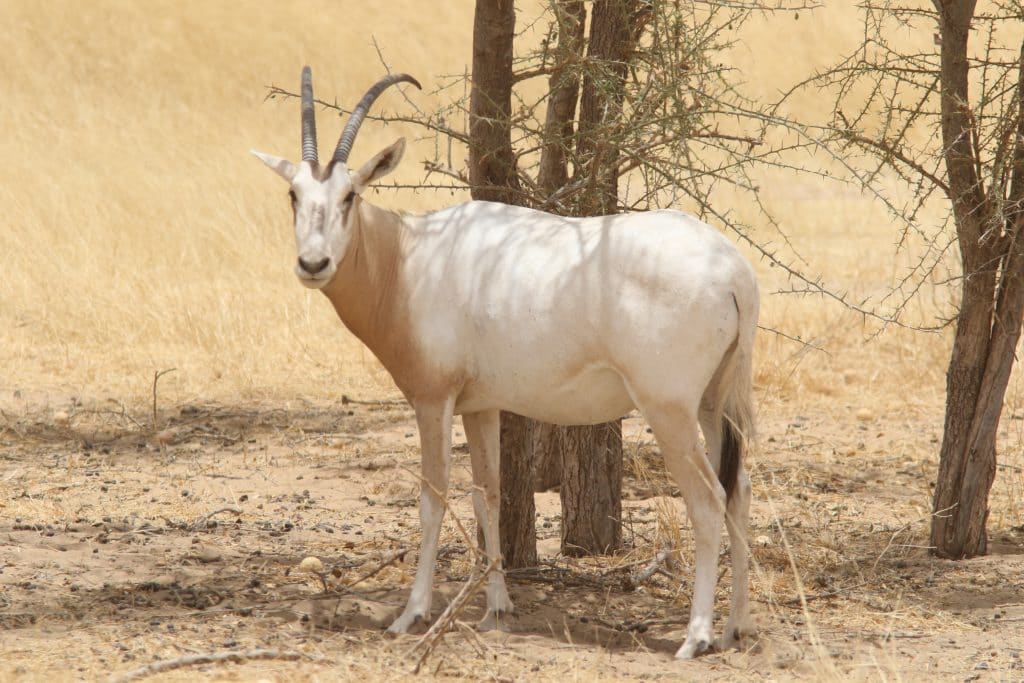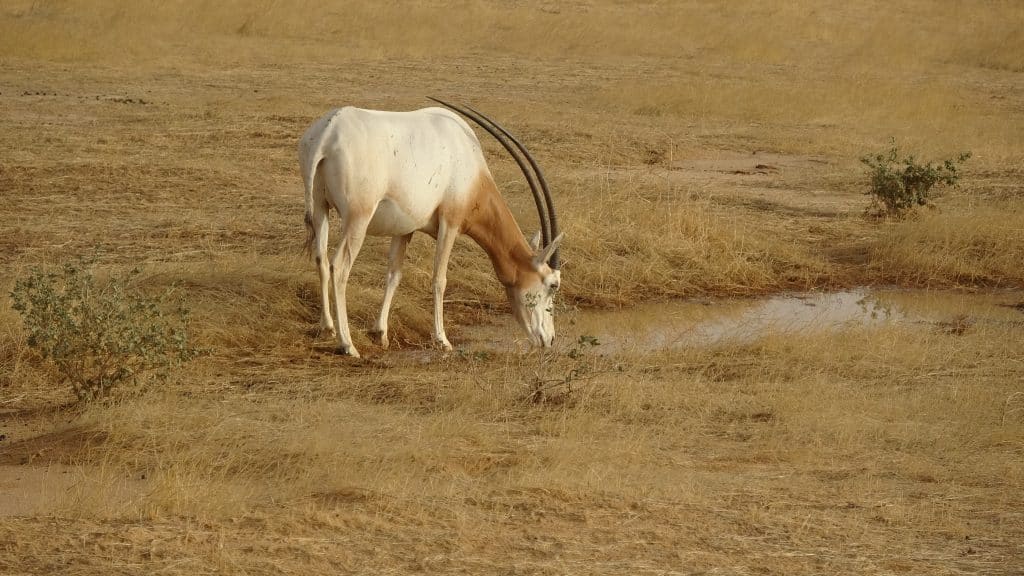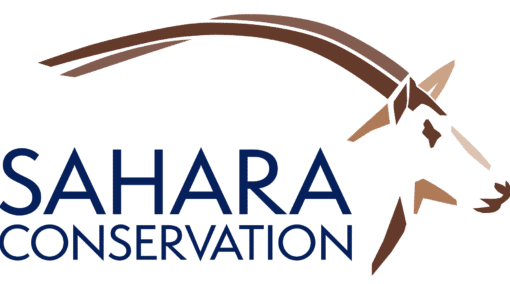SCF Oryx Project Receives Strong Presidential Support

As SCF’s logo, the oryx represents the threats that face desert wildlife but also the hope that one day this magnificent animal will once again roam free on African soil. This once abundant species of antelope occupied the vast, dry, sub-Saharan grasslands but fell prey over time to a lethal combination of overhunting, drought and habitat loss.Thankfully, significant numbers of oryx exist in collections across the world and efforts to restore the species to the wild are underway in Tunisia, Senegal and Morocco. Confined as they are to relatively small fenced protected areas, often situated in atypical or heavily impacted habitat, the oryx has yet to gain its freedom to breed, disperse and reoccupy its historical sub-desert range.
Up until the late 1970s, the oryx and other associated desert animals, such as the dama gazelle, ostrich and addax, prospered in Chad’s Ouadi Rimé-Ouadi Achim Game Reserve, one of the world’s largest protected areas. Regrettably, Chad’s oryx were exterminated during the 1980s largely as a result of civil war in that country. Recent surveys, however, carried out by SCF and Chad’s National Parks and Wildlife Service have underlined the reserve’s enormous potential to host a successful oryx reintroduction project. There is abundant habitat and space to cater for the oryx’s needs and migrations. Initial contacts with the local authorities and the reserve’s inhabitants have also been very encouraging.
With project development in mind, SCF organized a major stakeholder workshop in the Chadian capital of N’Djaména in May this year. Facilitated by IUCN’s Conservation Breeding Specialist Group, the workshop and fieldtrip that preceded it brought together around 40 people from diverse interest groups, including local politicians and representatives from the reserve’s herders associations.
The results were extremely positive, paving the way for detailed project development to take place. The initiative not only has the strong backing of Chad’s Environment ministry but also the President of Chad himself, Mr Idriss Deby Itno. Called in to brief the President on the initiative, SCF’s Chairman, Dr Steve Monfort, and Director, John Newby, were warmly received and were able to share with the President and his senior advisers information on the importance of wildlife conservation in Chad and the hopes for the restoration of the oryx. A keen conservationist, Mr Deby warmly welcomed the initiative, promising his personal support and that of his government.
Over the coming months, SCF and its partners will be working closely with the Chadian authorities to develop a full project proposal that will combine oryx reintroduction with protected area management in a mutually reinforcing way. Starting from a core protection zone of several thousand square kilometres, oryx will be brought in, acclimatized, released and monitored. Over time, further animals will be released and secondary sites developed to create a network of recovery points within the reserve. Partnerships will be developed with the local communities and agencies active in the area’s developmentto ensure that win-win solutions can be found in developing the reserve’s space and resources for the mutual benefit of both people and wildlife.

The oryx reintroduction project is one of the most ambitious ever undertaken by SCF and we would like to thank the following organizations for their support, generosity and counsel in making this possible: HH Sheikh Mohammed bin Zayed Al Nahyan, Addax & Oryx Foundation, Al Ain Zoo & Aquarium, Convention on Migratory Species, Emirates Center for Wildlife Propagation, Environment Agency of Abu Dhabi, Fossil Rim Wildlife Center, International Fund for Houbara Conservation, IUCN Conservation Breeding Specialist Group, Marwell Wildlife, Mohammed bin Zayed Species Conservation Fund, Noé Conservation, Oxford University WildCRU, Royal Belgian Institute of Natural Resources, Saint Louis Zoo, Smithsonian Conservation Biology Institute, Zoological Society of London.


Superb post however I was wanting to know if you could write a litte more on this topic? I’d be very grateful if you could elaborate a little bit more.
Nice post. I learn something new and challenging on blogs I stumbleupon on a daily basis.
Also I ve shared your site in my social networks!
I am truly thankful to the owner of this web site who has shared this fantastic piece of writing at at this place. Watch bbc persian news
very informative articles or reviews at this time.
Very well presented. Every quote was awesome and thanks for sharing the content. Keep sharing and keep motivating others.
You re so awesome! I don t believe I have read a single thing like that before.
Hello very cool site!! Man .. Excellent ..
Amazing .. I will bookmark your web site and take the feeds additionally?
I’m glad to search out so many helpful info right here
in the put up, we want work out extra techniques
on this regard, thanks for sharing. . . . . .
I just like the helpful information you provide in your articles
Awesome! Its genuinely remarkable post I have got much clear idea regarding from this post
The CBD SEO Workings delivers top-notch services pro businesses in the thriving CBD industry. With a vital come close to to Search Motor Optimization (SEO), they [url=https://cbdlocalseo.com ]cannabis seo[/url] overshadow in enhancing online visibility and driving consistent traffic. Their mastery lies in tailoring SEO strategies specifically representing CBD companies, navigating the unique challenges of this place market. Through inclusive keyword enquiry, size optimization, and link-building tactics, they effectively increase search rankings, ensuring clients take out of pocket amidst competition. Their group’s hallowing to staying updated with enterprise trends and search motor algorithms ensures a lively and junk approach. The CBD SEO Agency’s commitment to transparency and patient communication fosters safe keeping and reliability. All-embracing, their specialized services cater to the noticeable needs of CBD businesses, making them a valuable fellow-dancer in navigating the digital aspect within this competitive market.
Thank you very much for sharing, I learned a lot from your article. Very cool. Thanks. nimabi
Revitalize your exam preparation with our innovative ‘online exam help’ service. Our team is primed to create a symphony of success. Embrace this fresh approach and dance to the rhythm of academic brilliance.
I gave [url=https://www.cornbreadhemp.com/products/cbd-balm ]cbd balm 500mg[/url] a try for the treatment of the primary adjust, and I’m amazed! They tasted distinguished and provided a sense of calmness and relaxation. My importance melted away, and I slept less ill too. These gummies are a game-changer an eye to me, and I extremely commend them to anyone seeking unconstrained worry liberation and well-advised sleep.
A big thank you for your blog.Much thanks again.
Vous pouvez utiliser un logiciel de gestion des parents pour guider et surveiller le comportement des enfants sur Internet. Avec l’aide des 10 logiciels de gestion parentale les plus intelligents suivants, vous pouvez suivre l’historique des appels de votre enfant, l’historique de navigation, l’accès au contenu dangereux, les applications qu’il installe, etc.
You’re so awesome! I don’t believe I have read a single thing like that before.Live TV
You have noted very interesting details! ps decent web site.-mediathek vox
urveillez votre téléphone de n’importe où et voyez ce qui se passe sur le téléphone cible. Vous serez en mesure de surveiller et de stocker des journaux d’appels, des messages, des activités sociales, des images, des vidéos, WhatsApp et plus. Surveillance en temps réel des téléphones, aucune connaissance technique n’est requise, aucune racine n’est requise. https://www.mycellspy.com/fr/tutorials/
I really like reading through a post that can make men and women think.Motorcycle Cover All Season Universal Weather Waterproof Motorbike Cover with Lock-Holes
Your point of view caught my eye and was very interesting. Thanks. I have a question for you. https://www.binance.info/en/join?ref=RQUR4BEO
lso thank you for allowing me to comment!. – hey dudes kids
You have a real talent for this topic. illplaywithyou
I used to be recommended this blog through my cousin. I am not sure whether this submit is written via him as no one else understand such certain approximately my difficulty. You are wonderful! Thank you!
sandyterrace.com
기녀사원의 가장 큰 특징은 종종 다양한 활동이다.
Hi there, just became aware of your blog through Google, and found that it is truly informative.
I am going to watch out for brussels. I will be grateful if you continue this
in future. A lot of people will be benefited from your
writing. Cheers!
Thank you, I have recently been searching for information approximately this topic for a while and yours is the best I have found out so far. However, what concerning the conclusion? Are you positive concerning the source?
Article writing is also a fun, if you know then you can write otherwise it is complex to write.
I used to be suggested this web site through my cousin. I am no longer positive whether this submit is written by him as no one else recognize such specified about my
difficulty. You are incredible! Thanks!
Great information shared.eally enjoyed reading this post thank you author for sharing this post.
You have a gift for explaining things. hot nude cams
Thanks for sharing. I read many of your blog posts, cool, your blog is very good.
I’m excited for what you’ll share next. Best Adult Webcams
buy medicines online in india http://indiaph24.store/# mail order pharmacy india
indian pharmacy
indian pharmacy paypal https://indiaph24.store/# online pharmacy india
Online medicine order
purple pharmacy mexico price list: Mexican Pharmacy Online – mexican pharmaceuticals online
buying prescription drugs in mexico online [url=http://mexicoph24.life/#]mexico pharmacy[/url] mexican mail order pharmacies
http://canadaph24.pro/# canadian pharmacy victoza
safe canadian pharmacies [url=https://canadaph24.pro/#]Prescription Drugs from Canada[/url] canadian drugs
https://finasteride.store/# buying cheap propecia without dr prescription
https://cytotec.club/# buy cytotec pills
buy cipro online canada [url=https://ciprofloxacin.tech/#]where can i buy cipro online[/url] cipro for sale
Abortion pills online: cytotec pills buy online – buy cytotec over the counter